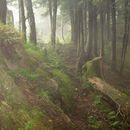en
names in breadcrumbs


The dwarf musk deer or Chinese forest musk deer (Moschus berezovskii, Chinese: 林麝; pinyin: Lín shè) is an artiodactyl native to southern and central China and northernmost Vietnam. The species name is after the collector Mikhail Mikhailovich Berezovsky. On June 14, 1976, China entered the dwarf musk deer onto its endangered species list.[3] Four subspecies are recognized:[4]
As most animals, the dwarf musk deer harbours a number of parasites.[5] In 2021, a study showed that ten species of Eimeria, which are apicomplexan protozoans living in the digestive tract, were specific of this host.[6]
The dwarf musk deer or Chinese forest musk deer (Moschus berezovskii, Chinese: 林麝; pinyin: Lín shè) is an artiodactyl native to southern and central China and northernmost Vietnam. The species name is after the collector Mikhail Mikhailovich Berezovsky. On June 14, 1976, China entered the dwarf musk deer onto its endangered species list. Four subspecies are recognized:
Moschus berezovskii berezovskii Flerov, 1929 Moschus berezovskii bijiangensis Wang & Li, 1993 Moschus berezovskii caobangis Dao, 1969 Moschus berezovskii yanguiensis Wang & Ma, 1993